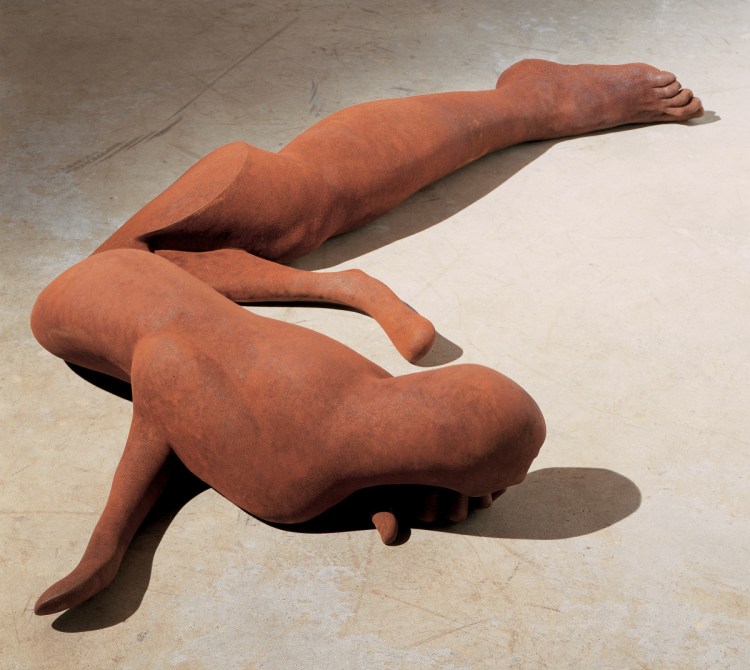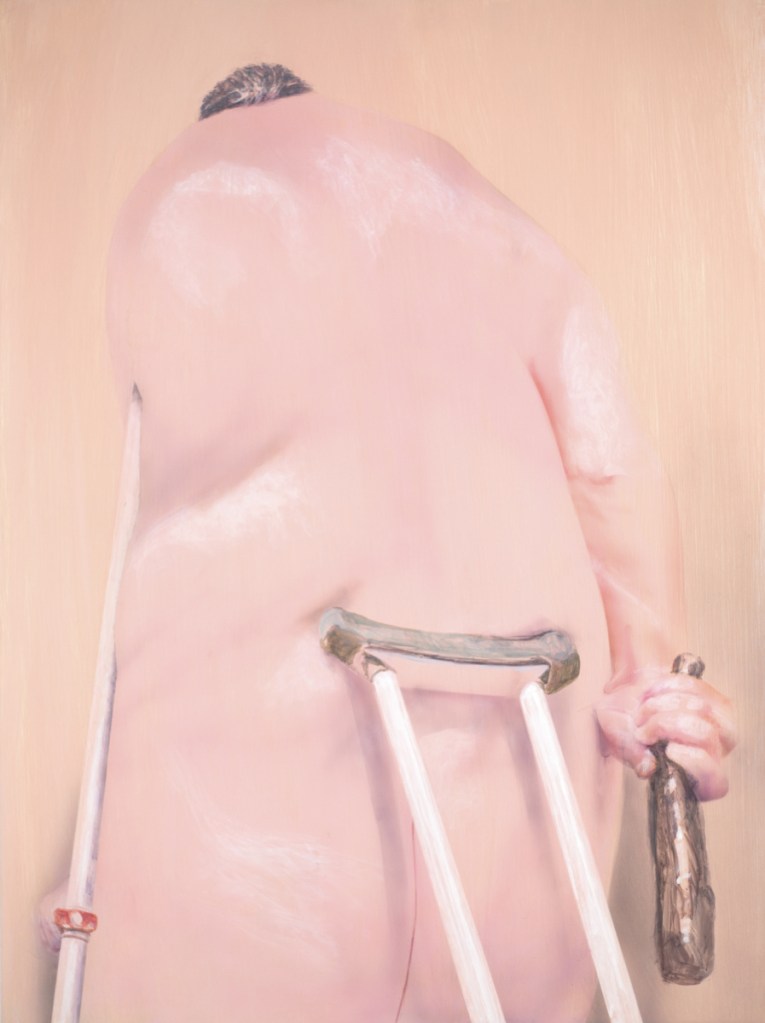“Rona Pondick and Robert Feintuch: Heads, Hands, Feet; Sleeping, Holding, Dreaming, Dying” at the Bates College Museum of Art is profound, engaging, disturbing and exciting. It’s also almost over and likely will be the best show in Maine this year, so don’t miss it.
Feintuch is a Bates professor and has work in the collection of the Portland Museum of Art. But don’t get the wrong idea. Feintuch is a New York artist who commutes, and the chance to see his work is rare in these parts.
“Heads,” in fact, is a much rarer opportunity than one might think: While Pondick and Feintuch are a married couple who met at the Yale University School of Art in 1975, this is their first major two-person show, and Feintuch’s first at Bates.
Despite his local footing, Feintuch is an important international artist. Both he and Pondick show with Sonnabend Gallery in the U.S. and across the pond, but she is a worldwide art star – and for good reason. Her sculpture, which combines human and animal elements, is striking, uncomfortably odd and powerful. It’s also some of the best crafted sculpture I have ever seen – and that purview includes classical sculpture that I studied in Europe.
Pondick’s “Wallaby,” for example, is a smooth-as-glass stainless steel with a stylized wallaby body, a tiny human head and a full-size human forearm as its left arm. The figure’s tail juts out straight, making it about 4 feet long. The subtle right bend in the tiny human neck and its gesture down to the left betray a deep understanding of Mannerist painting – the hyper-sophisticated affected style that immediately followed the High Renaissance. The creature seems to be aware of its own disproportion, the monstrosity of its own human arm.
The viewer’s response to a work like “Wallaby” (and therefore any of Pondick’s works) is a blend of physical revulsion and amazed captivation. The Freudian term for this type of oddity is “the uncanny” – a primary vehicle of Surrealism. To encounter something uncanny is to encounter something that is questionably alive. Moreover, this type of psychological response is palpably physical to the viewer, and the physicality of the viewer’s mental response is a basic element to the work of both Pondick and Feintuch.

Sonnabend Gallery, New York; Zevitas/Marcus Gallery, Los Angeles; and the artist
“Wallaby,” by Rona Pondick, 2007-12, stainless steel, 24 by 44 x 10 inches.
And while both are technical virtuosos, Pondick’s sense of sculptural finish moves beyond virtually anything in America. Maine museums have plenty of great painting. But we don’t have sculpture like Pondick’s. We see this in her work across finishes: Her strongest works include a milk-perfect, forward-facing painted bronze beaver with a human head, a cast rubber splay-legged marmot with the same close-eyed head hugging the ground with mismatched human hands for arms, and the bizarre rust-colored “Untitled Animal” that looks like a big cat crawling into being from a discarded human leg.
Feintuch’s abilities appear more easily in his earlier works. “Standing with Newspaper” (2007) features a bald standing man seen in profile with his head bent forward, wearing only (white) shorts, holding a newspaper in his near hand. Behind him a simple table remains only partially painted. Feintuch’s touch with acrylic emulsions rivals that of the best watercolorists. The wall behind and the absent shorts act like the white of watercolor paper. The reductive scene gets complicated with open form. It’s a masterwork of feigned simplicity.
Feintuch’s newer work incorporates the sense of volume in a way that activates our physical (rather than just visual) response. We see “Fat Hercules” (2011), for example, from behind. He is bloated, soft-pink from disuse and propped up by a crutch at his side and another at his lower back. Next to the butt crutch is a cudgel Hercules also hides behind his back. The club has a double effect: It reminds us of his offensive ferocity, but also of his personal need to make up for the deficits of his befallen state. As both a potent phallic stand-in and a sign of his increasing impotence, it’s a mixed message.
Pondick’s figures are similarly complex, and she competently spreads out in several directions. Her “Dog” combines a seemingly symmetrical (but nothing here is so simple) and highly-polished yellow stainless steel dog body with a close-to-life-sized human head – a leitmotif of Pondick’s work that, with its closed eyes, we should take as a self-portrait of Pondick’s own head. (It’s also the main event in the little “Mouse,” among others.) It’s part sphinx, part watchdog and part nightmare. The closed eyes hint at the process of casting a person’s head, but also at dreams or death, an idea that carries over to Feintuch’s most iconic works.

“Legs Up,” by Robert Feintuch, 2013, polymer emulsion on honeycomb panel, 28 by 36 inches.
“Legs Up” (2013) might be Feintuch’s most complete image. Clouds occupy the center of the image, with a soft blue sky above and ground-like clouds below. (He is a cloud master.) Between the two layers of cloud is a sliver of a man’s torso and head with a pointing-fingered hand at the edge. Rhetorical gestures such as this hand were a mainstay of Renaissance painting (think da Vinci’s John the Baptist or God’s gesture toward Adam in Michelangelo’s Sistine Chapel), and they play a key supporting role in both Pondick’s and Feintuch’s work. The legs – two feet with necrotically pole-thin lower legs jutting straight up – of “Legs Up” can read as a symbol of death; and they certainly cannot line up with the torso. Then again, the torso could be a dreaming sleeper, with the hand gesture as a reminder that a dreamer is a type of creative god. The legs, from that perspective, could read in many ways, including as a symbol of someone diving deep into a dream.
Nor is this creative god-like perspective unique for “Heads.” Besides Hercules, Feintuch presents himself as the wine-god Bacchus, again from the back (the big flat pink back is a thing; and it’s brilliantly hilarious), alone with his beloved grapes. We see Feintuch as Bacchus again in “Two-Fisted,” but this time with a more direct reference to Mannerists like Michelangelo (yup), with a deliciously affected left hand (curved fingers and matching gestures). “Two-Fisted,” as well, is a testament to Feintuch’s ability with the brush. The left hand is thrown into relief by the figure’s flat, chair-like back, and it’s complemented by his scratchy swaths of salt-and-pepper hair – an extraordinary passage of painting.
“Heads” is truly a remarkable exhibition on many levels. Feintuch and Pondick are both notably spare, which adds a sense of clarity. Their work digs deep in art history (while the nods are to the Mannerists, the true shadow is cast by the late Philip Guston), but since the work elicits a physical response in the viewer, it’s accessible to anyone. The work is dazzling from a technical perspective (a little star power doesn’t hurt), and it is gorgeously displayed in the museum’s handsome main gallery.
Freelance writer Daniel Kany is an art historian who lives in Cumberland. He can be contacted at:
dankany@gmail.com
Copy the Story LinkSend questions/comments to the editors.




Success. Please wait for the page to reload. If the page does not reload within 5 seconds, please refresh the page.
Enter your email and password to access comments.
Hi, to comment on stories you must . This profile is in addition to your subscription and website login.
Already have a commenting profile? .
Invalid username/password.
Please check your email to confirm and complete your registration.
Only subscribers are eligible to post comments. Please subscribe or login first for digital access. Here’s why.
Use the form below to reset your password. When you've submitted your account email, we will send an email with a reset code.